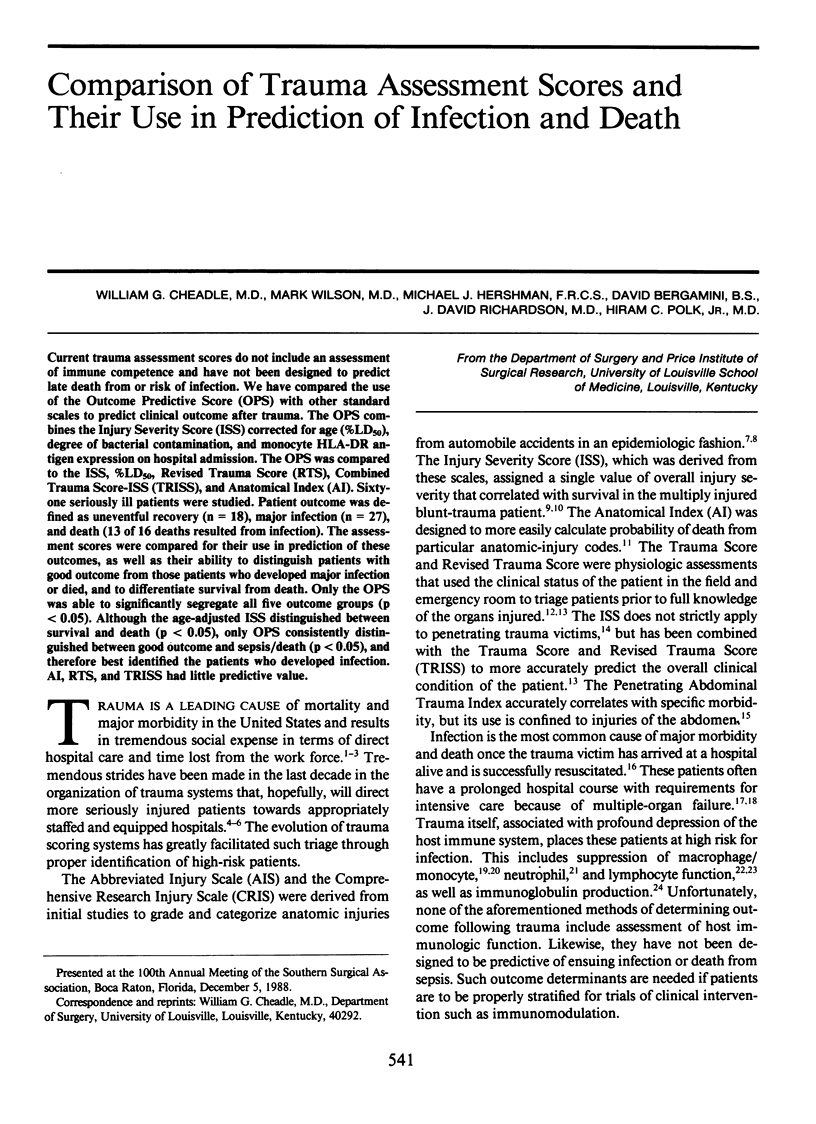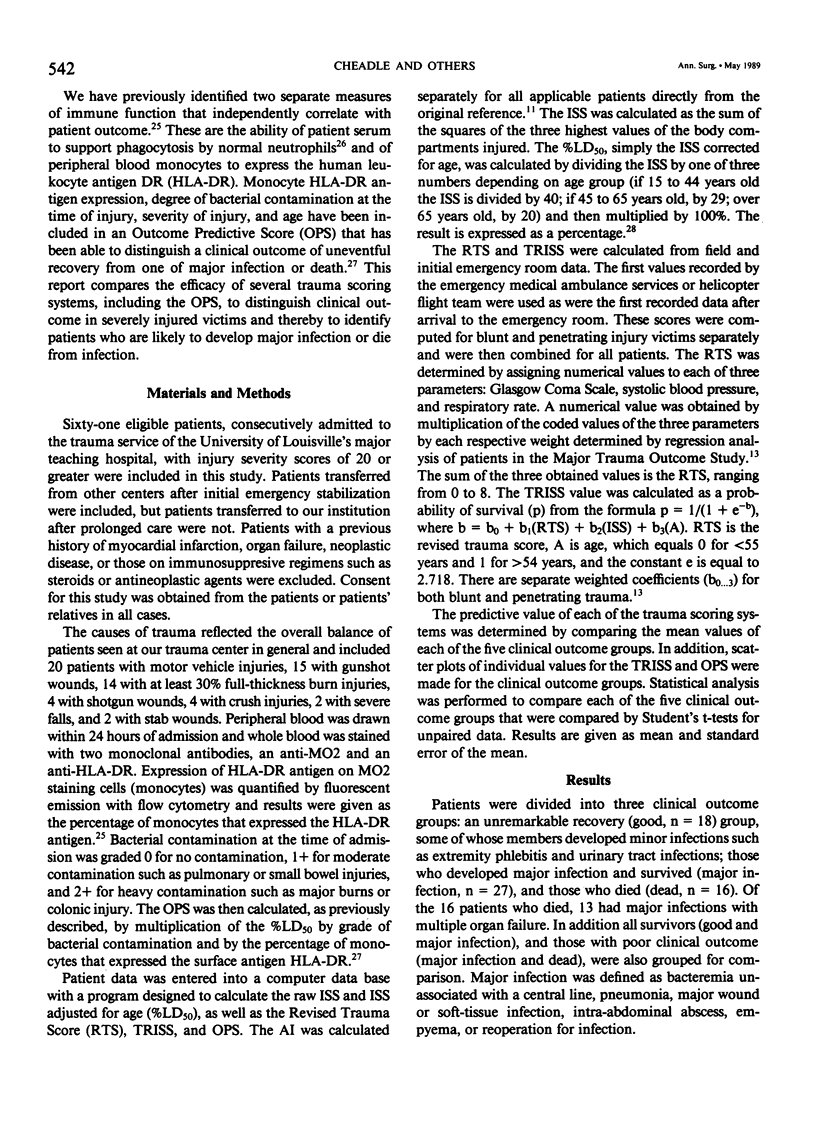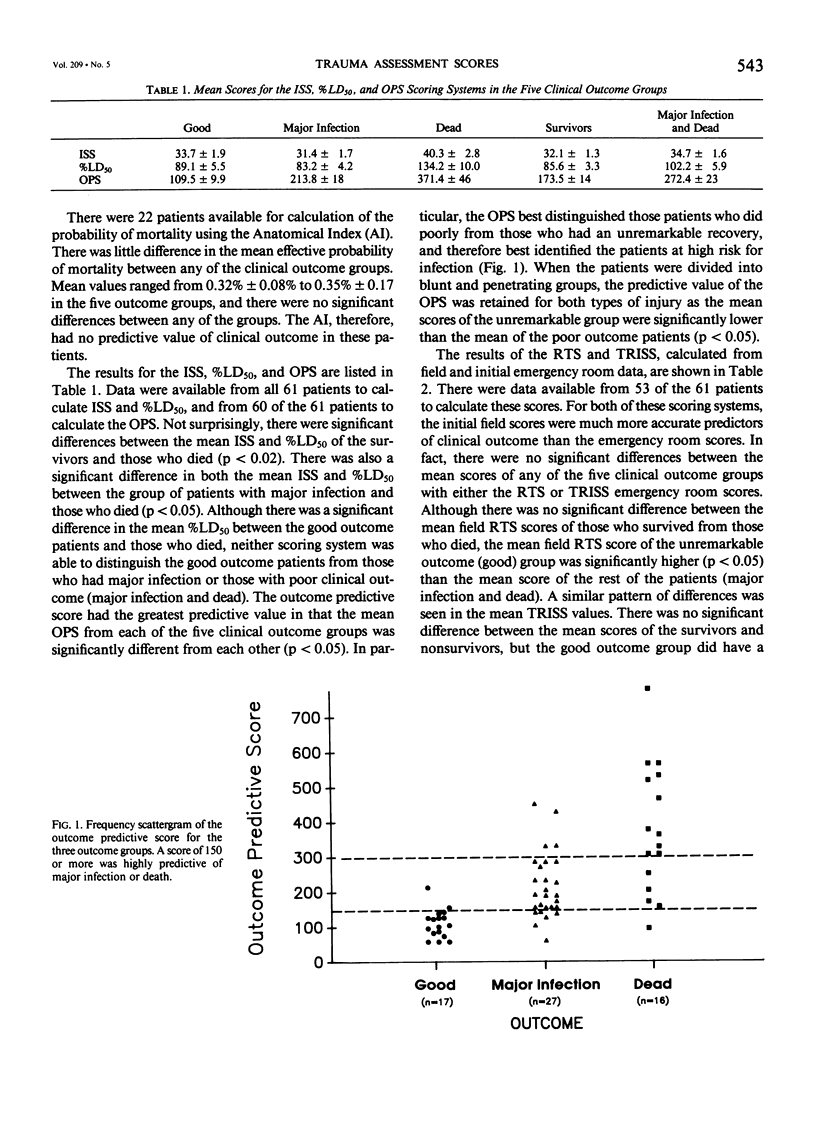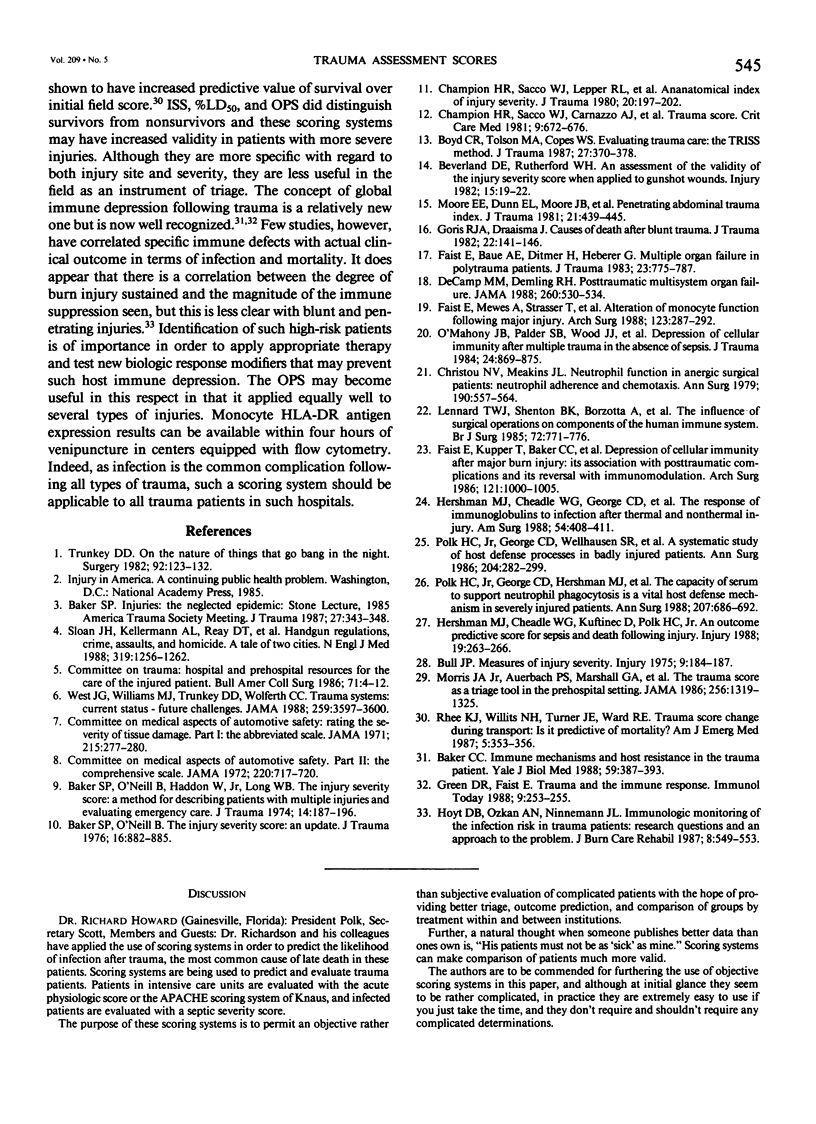Abstract
Current trauma assessment scores do not include an assessment of immune competence and have not been designed to predict late death from or risk of infection. We have compared the use of the Outcome Predictive Score (OPS) with other standard scales to predict clinical outcome after trauma. The OPS combines the Injury Severity Score (ISS) corrected for age (%LD50), degree of bacterial contamination, and monocyte HLA-DR antigen expression on hospital admission. The OPS was compared to the ISS, %LD50, Revised Trauma Score (RTS), Combined Trauma Score-ISS (TRISS), and Anatomical Index (AI). Sixty-one seriously ill patients were studied. Patient outcome was defined as uneventful recovery (n = 18), major infection (n = 27), and death (13 of 16 deaths resulted from infection). The assessment scores were compared for their use in prediction of these outcomes, as well as their ability to distinguish patients with good outcome from those patients who developed major infection or died, and to differentiate survival from death. Only the OPS was able to significantly segregate all five outcome groups (p less than 0.05). Although the age-adjusted ISS distinguished between survival and death (p less than 0.05), only OPS consistently distinguished between good outcome and sepsis/death (p less than 0.05), and therefore best identified the patients who developed infection. AI, RTS, and TRISS had little predictive value.
Full text
PDF




Selected References
These references are in PubMed. This may not be the complete list of references from this article.
- Baker C. C. Immune mechanisms and host resistance in the trauma patient. Yale J Biol Med. 1986 Jul-Aug;59(4):387–393. [PMC free article] [PubMed] [Google Scholar]
- Baker S. P. Injuries: the neglected epidemic: Stone lecture, 1985 America Trauma Society Meeting. J Trauma. 1987 Apr;27(4):343–348. [PubMed] [Google Scholar]
- Baker S. P., O'Neill B., Haddon W., Jr, Long W. B. The injury severity score: a method for describing patients with multiple injuries and evaluating emergency care. J Trauma. 1974 Mar;14(3):187–196. [PubMed] [Google Scholar]
- Baker S. P., O'Neill B. The injury severity score: an update. J Trauma. 1976 Nov;16(11):882–885. doi: 10.1097/00005373-197611000-00006. [DOI] [PubMed] [Google Scholar]
- Beverland D. E., Rutherford W. H. An assessment of the validity of the injury severity score when applied to gunshot wounds. Injury. 1983 Jul;15(1):19–22. doi: 10.1016/0020-1383(83)90156-0. [DOI] [PubMed] [Google Scholar]
- Boyd C. R., Tolson M. A., Copes W. S. Evaluating trauma care: the TRISS method. Trauma Score and the Injury Severity Score. J Trauma. 1987 Apr;27(4):370–378. [PubMed] [Google Scholar]
- Bull J. P. Measures of severity of injury. Injury. 1978 Feb;9(3):184–187. doi: 10.1016/0020-1383(78)90004-9. [DOI] [PubMed] [Google Scholar]
- Champion H. R., Sacco W. J., Carnazzo A. J., Copes W., Fouty W. J. Trauma score. Crit Care Med. 1981 Sep;9(9):672–676. doi: 10.1097/00003246-198109000-00015. [DOI] [PubMed] [Google Scholar]
- Champion H. R., Sacco W. J., Lepper R. L., Atzinger E. M., Copes W. S., Prall R. H. An anatomic index of injury severity. J Trauma. 1980 Mar;20(3):197–202. doi: 10.1097/00005373-198003000-00001. [DOI] [PubMed] [Google Scholar]
- Christou N. V., Meakins J. L. Neutrophil function in anergic surgical patients: neutrophil adherence and chemotaxis. Ann Surg. 1979 Nov;190(5):557–564. doi: 10.1097/00000658-197911000-00001. [DOI] [PMC free article] [PubMed] [Google Scholar]
- DeCamp M. M., Demling R. H. Posttraumatic multisystem organ failure. JAMA. 1988 Jul 22;260(4):530–534. [PubMed] [Google Scholar]
- Faist E., Baue A. E., Dittmer H., Heberer G. Multiple organ failure in polytrauma patients. J Trauma. 1983 Sep;23(9):775–787. doi: 10.1097/00005373-198309000-00002. [DOI] [PubMed] [Google Scholar]
- Faist E., Kupper T. S., Baker C. C., Chaudry I. H., Dwyer J., Baue A. E. Depression of cellular immunity after major injury. Its association with posttraumatic complications and its reversal with immunomodulation. Arch Surg. 1986 Sep;121(9):1000–1005. doi: 10.1001/archsurg.1986.01400090026004. [DOI] [PubMed] [Google Scholar]
- Faist E., Mewes A., Strasser T., Walz A., Alkan S., Baker C., Ertel W., Heberer G. Alteration of monocyte function following major injury. Arch Surg. 1988 Mar;123(3):287–292. doi: 10.1001/archsurg.1988.01400270021002. [DOI] [PubMed] [Google Scholar]
- Goris R. J., Draaisma J. Causes of death after blunt trauma. J Trauma. 1982 Feb;22(2):141–146. doi: 10.1097/00005373-198202000-00011. [DOI] [PubMed] [Google Scholar]
- Green D. R., Faist E. Trauma and the immune response. Immunol Today. 1988 Sep;9(9):253–255. doi: 10.1016/0167-5699(88)91300-X. [DOI] [PubMed] [Google Scholar]
- Hershman M. J., Cheadle W. G., George C. D., Cost K. M., Appel S. H., Davidson P. F., Pork H. C., Jr The response of immunoglobulins to infection after thermal and nonthermal injury. Am Surg. 1988 Jul;54(7):408–411. [PubMed] [Google Scholar]
- Hershman M. J., Cheadle W. G., Kuftinec D., Polk H. C., Jr, George C. D. An outcome predictive score for sepsis and death following injury. Injury. 1988 Jul;19(4):263–266. doi: 10.1016/0020-1383(88)90042-3. [DOI] [PubMed] [Google Scholar]
- Hoyt D. B., Ozkan A. N., Ninnemann J. L. Immunologic monitoring of infection risk in trauma patients: research questions and an approach to the problem. J Burn Care Rehabil. 1987 Nov-Dec;8(6):549–553. [PubMed] [Google Scholar]
- Lennard T. W., Shenton B. K., Borzotta A., Donnelly P. K., White M., Gerrie L. M., Proud G., Taylor R. M. The influence of surgical operations on components of the human immune system. Br J Surg. 1985 Oct;72(10):771–776. doi: 10.1002/bjs.1800721002. [DOI] [PubMed] [Google Scholar]
- Moore E. E., Dunn E. L., Moore J. B., Thompson J. S. Penetrating abdominal trauma index. J Trauma. 1981 Jun;21(6):439–445. [PubMed] [Google Scholar]
- Morris J. A., Jr, Auerbach P. S., Marshall G. A., Bluth R. F., Johnson L. G., Trunkey D. D. The Trauma Score as a triage tool in the prehospital setting. JAMA. 1986 Sep 12;256(10):1319–1325. [PubMed] [Google Scholar]
- O'Mahony J. B., Palder S. B., Wood J. J., McIrvine A., Rodrick M. L., Demling R. H., Mannick J. A. Depression of cellular immunity after multiple trauma in the absence of sepsis. J Trauma. 1984 Oct;24(10):869–875. doi: 10.1097/00005373-198410000-00001. [DOI] [PubMed] [Google Scholar]
- Polk H. C., Jr, George C. D., Hershman M. J., Wellhausen S. R., Cheadle W. G. The capacity of serum to support neutrophil phagocytosis is a vital host defense mechanism in severely injured patients. Ann Surg. 1988 Jun;207(6):686–692. doi: 10.1097/00000658-198806000-00007. [DOI] [PMC free article] [PubMed] [Google Scholar]
- Polk H. C., Jr, George C. D., Wellhausen S. R., Cost K., Davidson P. R., Regan M. P., Borzotta A. P. A systematic study of host defense processes in badly injured patients. Ann Surg. 1986 Sep;204(3):282–299. [PMC free article] [PubMed] [Google Scholar]
- Rhee K. J., Willits N. H., Turner J. E., Ward R. E. Trauma Score change during transport: is it predictive of mortality? Am J Emerg Med. 1987 Sep;5(5):353–356. doi: 10.1016/0735-6757(87)90380-9. [DOI] [PubMed] [Google Scholar]
- Sloan J. H., Kellermann A. L., Reay D. T., Ferris J. A., Koepsell T., Rivara F. P., Rice C., Gray L., LoGerfo J. Handgun regulations, crime, assaults, and homicide. A tale of two cities. N Engl J Med. 1988 Nov 10;319(19):1256–1262. doi: 10.1056/NEJM198811103191905. [DOI] [PubMed] [Google Scholar]
- Trunkey D. D. Society of University Surgeons. Presidential address: On the nature of things that go bang in the night. Surgery. 1982 Aug;92(2):123–132. [PubMed] [Google Scholar]
- West J. G., Williams M. J., Trunkey D. D., Wolferth C. C., Jr Trauma systems. Current status--future challenges. JAMA. 1988 Jun 24;259(24):3597–3600. doi: 10.1001/jama.259.24.3597. [DOI] [PubMed] [Google Scholar]


